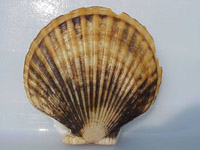Sea Scallop Recipes
Chipotle Seviche
Curried Sea Scallops
Mushroom Scallops
Pizza with Thai Peanut Sauce
Soy Mustard
Scallops
Seviche
Scallops
with Herbed Butter
Related Information
Cooking Scallops
Storing Fish
and Shellfish
Omega-3 Fatty Acids in Fish
Pictures

Outer scallop shell.

Scallop meat in the shell.
Ingredient Information
Sea Scallops
What you purchase in the market are actually the muscle that holds the two shells of the scallop together. Sea scallops are about 1 1/2 inches in diameter and should be a translucent beige, creamy color. Some will be slightly pink. (See also Bay Scallops.)
The best quality is "dry" or "dry pack" sea scallops. These are packed in muslin bags and kept on ice.
Because scallops don't live well out of water (as clams or oysters can) they are shucked when caught and kept chilled on board the fishing boat. Day boat scallops are the freshest and are so named because they are delivered to market the day of harvest.
If they are wet or white looking, they have been soaked in water to increase their weight. For years, many scallops have been treated with sodium tripolyphosphate (STP). These chemicals help to retain the natural moisture, but in excess, STP promotes the absorption of water into the scallop. This can increase the weight by as much as 25% and makes for a wet gummy scallop. The STP-treated scallops take on a white, opaque appearance and have a bitter chemical flavor. Look for scallops labeled "chemical free."
4 ounces sea scallops = 100 calories, <1g fat, 0g sat fat, 0g mono fat, 19g protein, 3g carbohydrates, 182mg sodium, 37mg cholesterol
Related Articles
Eat fish now. Eat fish later:
We know that fish high in omega-3 and
omega-6 fatty acids are good for you, but recent studies have not consistently
shown that eating these fish will help reduce the risk of specific cancers.
Fish Really IS Brain Food!
I’m sure you’ve heard the old saw, too: “Fish is brain food!” While research has shown that eating fish and omega-3 fatty acids have been associated with lower risk of Alzheimer disease and stroke, a study in the Archives of Neurology this month (Arch Neurol. 2005;62:1-5) seems to show that eating fish helps reduce the cognitive decline associated with aging.
Eating fish slows the progression of heart disease!
We have known for a long time that eating fish is good for you. Eating fatty
fish like tuna and salmon has been shown to reduce the risk of sudden death.
There has not been research, however, to show what effect eating fish might
have on the progression of the narrowing of arteries that feed blood to the
heart.
One fish, Two fish, Mercury in Your Fish
I had a patient ask about fish the other day. This was after I mentioned that with his risk factors for heart disease he would do well to eat at least two servings of fish per week. He responded that he was worried about the reports of "mercury and other stuff" in fish and wanted to know what to do.
